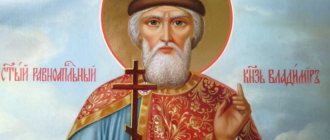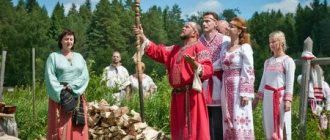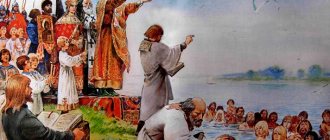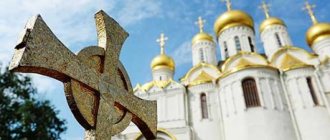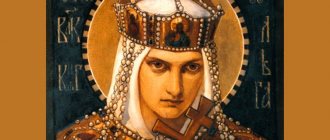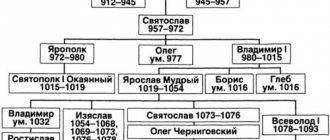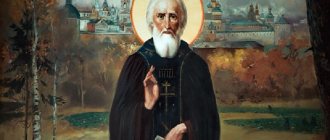Myth 1: Rus' was baptized by force, “with fire and sword”
The idea of the forced Baptism of Rus' developed in the historical science of Soviet times, from there it passed into popular literature - and thus became a “commonplace”. This is one of those cases when such “commonplaces” arise, if not out of nowhere, then with a minimum of justification. Rus' in the 10th century was just becoming a unified state. This is a society of universal armament of the people, autonomous tribes and tribal unions. Vladimir simply did not have the apparatus of suppression necessary for baptism by force. This is not the 20th century - and not even, for example, the Saxony of the early Middle Ages, where scattered tribal duchies had to deal with the far superior power of the Frankish Empire. But the prince was the highest spiritual authority for the pagan Slavs. It was this authority of the princely power that worked - the public shaming of pagan idols and the threat of becoming an “enemy” to the prince who had chosen a new faith was enough for the people of Kiev and residents of most other cities of Rus'. Another question is how conscious and sincere such an appeal was.
Not a single early source, written within a century and a half after the events, speaks of forced baptism. On the contrary, contemporaries were amazed at the lack of open resistance - which would be very strange if “in fact” it was massive. “Fire and Sword” is known to us exclusively from one text - the Joachim Chronicle cited by the historian of the 18th (!) century V.N. Tatishchev. Judging by the language and content, this is a very late monument; it reached us only in Tatishchev’s “Russian History”. Firstly, the Joachim Chronicle itself emphasizes that the matter concerned only Novgorod - “people reviled the Novgorodians,” that they alone were baptized “with fire and sword.” Secondly, the Joachim Chronicle is not only a late source, but also of very dubious origin. Some scientists believe that this is the creation of Tatishchev himself, others that the “chronicle” was created without his knowledge in order to satisfy his scientific interest, and then edited by him. Maybe it used some ancient text, maybe not. Archaeologists find confirmation of a fire in the city at the end of the 10th century, but what it was connected with and how accurately the “chronicle” conveys the events remains unknown. The “obnoxious” proverb that “Putyata baptized the Novgorodians with the sword, and Dobrynya with fire” is the only and rather fragile evidence that some kind of conflict occurred in Novgorod at the time of baptism. The conflict is so local that for centuries it remained the subject of only oral traditions. Where baptism was really opposed, as in Rostov or Murom, Vladimir postponed it until better times, rather than sending vigilantes to storm rebellious cities.
It should also be remembered that by 988 Christianity was no longer alien to Rus'. There were many Christians in the princely squad, among the merchants. Christian missions operated in Rus' and churches existed. Several princes from the end of the 8th to the 10th centuries were baptized. Vladimir’s change of faith was sufficiently prepared and did not come as a shock to his subjects. Residents of Russian cities could not help but think about religious issues; they could not remain blind adherents of paganism when it lost the support of the authorities.
“Collective farm” chic and nighties: the most ridiculous opening outfits of the OIFF 2019
We will begin our review with a Hollywood star who arrived at the Odessa Film Festival this year. True, few people recognized the celebrity - the short haircut and simply flashy dress, similar to a beach sundress, literally “merged” with the bad taste of the rest of the guests. Eh, Rose, where is the Hollywood chic? Facebook
And this is an outside view of the red carpet. But this photo reminded commentators on social networks of an adult film festival - the guests look so unkempt and stale in their outfits and especially their hairstyles. If in general, poorly painted roots and a “crow’s nest” in combination with vulgar, overly bright makeup give certain associations. And they - alas, are not about Babette from the films of the 1960s. Facebook
They say: “from the ship to the ball!” But here, it’s more like “from bed to ball.” The girl with dark hair clearly made a mistake with the dress - it just looks like an expensive, good quality and beautiful... nightie. The girl's outfit in black also raises questions - the jacket and skirt, although made in the same color, look ridiculous - as if the girl could not choose what to wear and decided to go because the first one fell out of the closet. And of course, the most important thing in this photo that catches the eye is, excuse me, the nipples. Apparently, these girls didn't have any underwear out of the closet. Facebook
This photo is surreal and a parody of Hollywood photographs, where stars such as Angelina Jolie or Cameron Diaz playfully expose their legs from the folds of their dresses. But looking at this photo, associations come with “collective farm” rather than Hollywood chic. But what a leg - so chic. And sandals with feathers give the associations even more form. Facebook
Kamalia looks as always - bright and even too much. But it’s interesting - despite all the painstaking work on the dress, the bodice of the dress looks as if it would burst right now. And judging by the outline of her figure, Kamaliya supported this topless trend and decided to appear on the red carpet without a bodice. Facebook
And of course, what would a red carpet in Odessa be without our favorite beach sundresses! Rose McGowan aside, this dress is a true masterpiece! The girl chose flashy pink, a tote bag and open-toed sandals, breaking all the rules of etiquette at once. But the most important thing is the belt with the name “Anna”. Perhaps this is the name of the socialite diva? Facebook
Let's leave the lady in a black dress with a bag - her image even more or less fits into the so-called “smart casual” even despite the sports sandals. Our attention entirely belongs to the blonde in blue, because her image is the quintessence of bad taste and real vulgarity. A blue dress only emphasizes a woman’s age, and also reveals all the flaws in her figure and appearance - an unkempt hairstyle, a tan. And in general, the whole image resembles Malvina, who has lost her mind. Facebook
And this is the situation when the dress is beautiful, and the image itself is good. But here are the breasts... The festival of dresses on the naked body continues, and here the guest was literally let down by her breasts, or rather, her image. Facebook
Pink became a real hit at the Odessa Film Festival. But alas - in the bad sense of the word. Here the ladies chose flowing dresses in the style of goddesses in the pink shade of dawn. But this shade is more suitable for young girls than for older ladies, since it will not help hide age at all. And judging by what we see in the picture, it’s even the other way around. Facebook
And again - “topless festival”. But although the green tint suits the girl, the fabric itself is almost transparent. Thus, based on the appearance of a girl, you can study anatomy. But are we here to watch a movie? Facebook
And again - pink, and again - mistake! If on one lady a dress with open shoulders looks even more or less, then the second dress is just a failure. The soft pink color again reminded me of a nightie, the glitter gives, so to speak, a “glimmer of cheapness.” But the worst thing is the fake buttons that fasten the dress. It looks ridiculous, inappropriate and makes you think - what will happen if these buttons come undone? Facebook
What's going on in this photo? Either a movie about friendship with the peoples of the East, or Ukrainian futurism. This is because the dress in the Ukrainian style of Sergei Tigipko’s wife fits perfectly on the red carpet, but the other girl looks like a guest from the future. But looking at her bright dress and her too bright, to the point of incomprehensibility and absurdity, image, I want to ask - what future awaits us? Facebook
Once again, robes appeared on the red carpet. Although this is not surprising, considering that we have already seen several dresses in the “boudoir chic” style. Here it’s just a combo! Pink, multiplied by the “boudoir” style, gave birth to a robe dress, which is suitable, perhaps, for the bedroom of an opera singer, but certainly not for the red carpet near the Opera House. Facebook
Here comes the green one! We're joking. Again - pink and again the style of the dress is not at all suitable for their owners. The bright pink shade again emphasized all the flaws of the figure and especially the chubby arms, and the style was reminiscent of a combination. Beautiful, with ruffles and lace, but alas, a combination that has no place at all on the red carpet. Still, pink is the color of youth. Facebook
A fairy from childhood dreams or a nightmare? Trans diva Monroe chose an extremely strange outfit for the film festival - a wreath and wig, as if from a fairy tale, and a dress with a painted fox. This, of course, is very cute at a children's party and Monroe would gain popularity there, but at a film festival such a dress looks extremely strange. Although it probably fits perfectly in the caravan of robe dresses, nighties and topless dresses. Facebook
And this is designer Jean Gritzfelt, and he became just a star on the red carpet. But even in the abundance of bad taste and vulgarity, Jean’s outfit looked, alas, too much. Facebook
Ballet and Opera always go hand in hand. Ballet is a fine art and there is always a place and time for it, because it is a fine art. Apparently, this is what the guest thought when she put on a similar blouse. I wanted it to be touching, light and airy, but it turned out... Like a kilogram of iron in a kilogram of cotton wool. Facebook
Let's finish our selection of the lady in red, who managed the main thing: to stand out against the backdrop of the red carpet. True, the girl stood out with her vulgar hairstyle from the 2000s and a dress that simply emphasized all the flaws in her figure. As a result, the elegant total red turned into the image of the heroine of adult films. Facebook
Myth 2: Rus' was baptized by the Western, not the Eastern Church
The baptism of Rus' from Byzantium, from the “Greeks,” is unambiguously and in detail reported not only by Russian sources - all unanimously - but also by contemporaries of the events. This is the Arab Christian historian Yahya of Antioch, and - what is especially important - the German chronicler Thietmar. Of course, this does not mean that the Western Church did not preach in Rus' or that in some periods this preaching was not even more active than that of the Byzantines. Princess Olga, the first among the Rurikovichs to be baptized - in Constantinople! - after the cooling of relations with Byzantium, she turned to the German king Otto for a bishop. However, this bishop did not stay in Rus' for long. Later, under Yaropolk and Vladimir, missionaries, probably Italian, worked in Kyiv. However, they did not succeed, which is reflected in the chronicle story about the “choice of faiths.” Receiving baptism from the Eastern Church allowed the Russians to listen to the word of faith in the temple in the Slavic language - an important circumstance at a time when the Latin clergy exterminated Slavic literacy in the Czech Republic, which had submitted to the West.
The Legend of Vladimir
True, this performance is mostly semi-legendary. Historians believe that the “legend” about Prince Vladimir, the baptist of Rus', began to take shape almost during the time of the author of “The Tale of Bygone Years,” Nestor the Chronicler. That is, back in the 12th century. The same “Tale” states that Vladimir’s grandmother, Princess Olga, converted to Christianity long before the baptism of all Russians.
Long before Princess Olga, Askold and Dir, the Kyiv princes who were brothers (according to the Tale) or the same person (according to some modern historians), became Christians.
Moreover, archaeological research and historical literary monuments confirm that Christian communities existed on the territory of Kievan Rus even before mass baptism.
There are several myths associated with the history of the baptism of Kievan Rus that need to be debunked, because, according to the expression of the ancients, “the truth is more precious.”
Myth 3: During the Baptism of Rus', high pagan culture perished, pre-Christian writing disappeared
There is no need to belittle or romanticize the culture of pagan Rus'. It was neither “higher” nor “lower” than the pre-Christian culture of the Germans, Celts or Balts - although it is unlikely that our civilized contemporaries would consider any of them high, looking at it closely. It is always better to indulge in romantic dreams at a distance... Now, when geometers and hydraulicians, philosophers and satirists study history, many “wonderful discoveries” have been made in the field of ancient cultures - but this is a separate and very sad topic. Science knows enough about the culture and life of the ancient Slavs, and all those interested can be referred to the works of archaeological specialists.
As for writing, there is some bewilderment in the hoarse debate around the “pre-Cyrillic script”. Those who perceive writing as a “point of national pride” and believe that it “ought to have existed” simply do not understand why this truly characteristic sign of civilization appears. And it appears for one of two reasons. Or with the emergence of bureaucracy and monetary relations, when people stop taking each other’s word for it, and rulers want to perpetuate their actions, or under cultural influence from the outside. For example, with the advent of religious teachings, for which the written word, Scripture, is sacred. In Hinduism, for example, the spoken word is sacred—and even with writing, sacred texts were not written down until very late times. But for some reason our authors of the “Vedic religion of the Slavs” believe that it should be “more written” than the Indo-Aryan one.
In reality, the Slavs, like many peoples, had a pictorial “proto-letter”, “lines and cuts” - symbolic, calendar and counting signs. They did not “perish,” but happily survived in folk peasant culture until the New Age, when they were used on counting tags, when creating carved calendars, and sometimes instead of signatures. A number of scientists provide evidence in favor of the fact that the Eastern Slavs, from the 9th century, had a non-Cyrillic writing system that resembled Germanic runes. However, the few testimonies about these “Russian letters” connect their appearance with Christian preaching - the “letters” appeared in Crimea, among the “Roman Rus” Christians who lived here for a long time. The few unreadable “rune-shaped” inscriptions discovered by archaeologists all date back to the 10th-11th centuries. Whether they are written in those very “Russian letters”, whether it is one system or several local ones, is unknown. A significant part of scientists generally doubt that we are talking about some kind of special writing, seeing in these - I repeat - truly isolated monuments secret writing or magical icons. The topic is interesting, but it seems to have nothing to do with the “death of pagan culture.” No culture can perish so completely that modern science cannot detect the slightest trace of it. But the real culture of pagan Rus' did not perish; in many ways it remained unchanged for a long time - and was inherited, reworked, and incorporated into Christian Russia.
Chapter 5. Korsun campaign
In no ancient Russian text, except for the Special Life, rejected matchmaking is not the reason for the campaign against Korsun. In the minds of people of the 11th century. the war did not need any further explanation. The prince was obliged to go on campaigns to support his squad. If the campaign was unsuccessful, then the chronicler began to speculate whether it was worth undertaking. If everything went well, then no doubt about its necessity arose. The only difficulty with the real circumstances of the Korsun War was that the recently baptized prince captured a Christian city, which also belonged to his ally. But this problem, as can be seen from “Memory and Praise” by Jacob Mnich and PrJ, was successfully resolved. The campaign was given a pious motivation: the prince wanted to bring teachers of Christianity for the people to Rus'.
In the Korsun legend, the prince was still a pagan, and no additional explanations for his actions were needed. A violation of logic occurs exclusively in the chronicle, where the story of the campaign is placed in the middle of a lengthy story about the baptism of Rus'. A.M. Ranchin points out that the interpretation of the campaign against Korsun as a conquest of faith belongs to the researchers, and not to the chronicler.663 The Korsun legend itself is very consistent: the prince goes to the next war, captures the Greek city and, filled with pride, sends him to the Greek kings for matchmaking. They answer him with agreement on the only condition: he must be baptized.
The historical basis of the Korsun legend was the capture of the city and the magnificent wedding of Vladimir and Anna. Judging by the contradictory indications of different churches as the place of the prince’s baptism, the legend that Vladimir adopted Christianity in Korsun appeared in Crimea. At the end of the 11th century. the clergy of the Tithe Church successfully propagated it in Kyiv. At the same time, changes were made to the story about the Christian Varangians. Contrary to reality, it was claimed that the Tithe was built on the site of their yard. Real Varangians, of course, could not live in the middle of the burial ground (see: Chapter 2. 3). It is not known why the monk of the Pechersk Monastery, who compiled the Initial Code in 1091, trusted the clergy of the Church of the Tithes so much.
Most researchers believe that Vladimir wanted to force the emperors to give him the promised bride. D. L. Talis suggested that the second goal of the campaign was the destruction of Chersonesos as a city through which the Byzantines set the Pechenegs against Rus'. A. Poppe believes that the Russian prince, already married to Anna, subjugated the rebellious Chersonesos to his brother-in-law. A.V. Gadlo believed that Vladimir’s goal was to seize Southern Crimea.664 This point of view, as we will see later, best agrees with reality.
All these studies have one common point of view - Kherson was completely ruined by Vladimir. S. A. Belyaev, based on his own many years of excavations in the Western region of the city and a detailed analysis of archaeological discoveries of the past and present, came to the conclusion that Chersonesos was not destroyed. At the end of the 10th century. Large basilicas are being replaced by small temples-chapels. For some time, only the Western region of Chersonesus was deserted, but this was not associated with total fires or any other military events. Only a few common graves and unclaimed treasures can be associated with the war. At the same time, S.A. Belyaev himself is convinced that Vladimir was baptized in Korsun. In his opinion, the correctness of this point of view is supported not only by the fact that the city was not destroyed, but also by the “basilica on the hill” that he re-examined. It was erected on the site of the previous one from materials obtained from its dismantling. The basilica stood on a natural hill, but from it in the direction of the “Western Basilica” there was a vast area covered with leveling fill approx. 1 m. This corresponds to the report of the chronicle about the construction of a temple by the prince “on the mountain, which was poured out among the hail, stealing sleep.”665 Continuous city life continued in Chersonesos until the end of the 14th century.666
These are very important conclusions, but they do not contradict the assumption of the capture of the city by a Christian prince. Construction of St. Vladimir's temple in the city was not necessarily connected with his baptism. In different chronicles and lives it is named differently. In the Primary Code and the Laurentian-Troitsk edition of The Tale of Bygone Years, he remains nameless. In all the lists of the Ipatiev edition of the Tale of Bygone Years, the church is dedicated to John the Baptist, and in the Lives of Life - to St. Vasily. Either there was no certainty about what the temple was actually called, or Vladimir built several of them. In this regard, it can be suggested that the seismic wave of the October earthquake of 989 reached Crimea. Traces of such catastrophic consequences as in Constantinople are not visible, but some of the large buildings could have fallen into disrepair. As archon of St. Vladimir could take part in the dismantling of old churches and the construction of new ones.
The capture of Chersonesos fits very well into the general direction of the military-political activities of St. Vladimir in the second half of the 980s. On the one hand, it was a continuation of the Volga-Caspian direction of his father. Vladimir first went against the Vyatichi, former tributaries of the Khazars, once conquered by Svyatoslav. Then he moved to Volga Bulgaria. The purpose of these actions was one - to ensure uninterrupted trade along the Baltic-Volga route. At that time, the mouth of the Volga was actually controlled by Shirvan Shah Mohammed, who helped the Khazars, defeated during the time of Svyatoslav, return to their original place. The Muslim Bulgarians were his co-religionists, and this could contribute to the formation of an alliance that was completely undesirable for Rus'. The victory over Volga Bulgaria and the peace concluded with it contributed to the further successes of St. Vladimir. The next year he went against the Khazars, and he managed to again take control of the mouth of the Volga. Svyatoslav, during his campaign in the North Caucasus against the Yasovs and Kasogs, also captured the Taman Peninsula.667 If Tmutorokan was lost during the time of Yaropolk, then Vladimir had to return this city. As a result of his victories, he managed to completely establish control over all branches of the Volga route (see: Chapter 2. 4).
The volume of eastern trade was steadily falling not only due to military-political circumstances on the Baltic-Volga route, but also due to the internal situation in the countries of the Arab Caliphate. In fact, it broke up into a number of independent possessions, which themselves continued to fragment. The successes of the Byzantine emperors in the wars with the Arabs and their return of a number of territories were precisely due to these processes. By the end of the 980s. The Central Asian state of the Samanids was on the verge of collapse, from which the bulk of silver dirhams came.668 In these circumstances, the importance of trade relations with Byzantium increased more and more.
In the 8th century all the Crimean possessions of Byzantium, the coast of Meotida (Sea of Azov), the Taman Peninsula and Zikhia to the south of it were under the rule of the Khazar Khaganate. Chersonesus, apparently, never submitted to the Khazars. In 830, the Kagan turned to Emperor Theophilus with a request to help in the construction of a fortress on the Don, the same Sarkel (White Vezha), which was subsequently captured by Svyatoslav. At the same time, the Kherson theme was founded in Crimea, which was also called Klimaty.669 It also included the Gothic principality with its capital in Doros (Mangup). The Gothic diocese, like the Kherson diocese, existed since the 4th century, and both survived even under the rule of the Khazars. Eastern Crimea, apparently, remained part of the Kaganate until the campaigns of Svyatoslav, when the prince, apparently, managed to capture the Bosporus (Khazar Kertz, Russian Korchev). But during the time of John Tzimisces, a strategist of the Empire was already mentioned in the Bosporus.670 Byzantium established itself on the Crimean side of the Kerch Strait.
The Kherson theme was the object of interest of Russian princes already in the first half of the 10th century. In the treaty between Igor and the Greeks in 944 there is an article “About the Korsun country”. It contains a ban on Russian princes to fight on the territory of the theme under any pretext. In exchange, the emperors promise the prince military assistance: “If the Russian prince asks for a war from us, ladies to him, as soon as you need it, let him fight.” The treaty does not say against whom this assistance is being provided, but it is clear that it could be some common enemies, most likely the Khazars.
The campaign against the Kherson theme was the logical conclusion of the military campaigns of St. Vladimir in the South. Chersonesos was not just the center of Byzantine possessions on the northern shore of the Black Sea. This was the key point that controlled navigation along the entire coast. It is not without reason that in the Southern Bay east of the ruins of Chersonesus in the 18th century. Sevastopol, the base of the Russian fleet, was founded. The capture of the Taman Peninsula was an important achievement, but it did not give control over the Black Sea.
There is no exact chronology of Vladimir’s campaigns before baptism. In the Initial Code and the Tale of Bygone Years, the war with Bulgaria is dated 985. Then the Khazar campaign dates back to 986. Probably, the campaign against Chersonesus was planned at the same time. Vladimir's baptism and alliance with the emperors postponed it, but did not change the prince's intentions. The fact that Anna did not arrive until the spring of 989 could not be a pretext for war with the Empire. It is clear that in the midst of hostilities with an uncertain outcome, it was impossible to demand the sending of the bride. Either Vladimir decided to round off his possessions until the positions of the emperors were strengthened, or the transfer of Chersonesos to Rus' was part of an agreement with Byzantium. The emperors were in a hopeless situation and could even make such a concession.
Knowing the peculiarities of Byzantine foreign policy and diplomacy, it can be assumed that, having agreed to the transfer of the city, Vasily nevertheless warned Chersonesos of the impending danger. Considering the presence in the city of at least two “friends” of the Russian prince, there is no doubt that St. Vladimir promptly learned about the preparations for the siege. Such an assumption may seem like an unnecessary modernization of events, but let’s look at what they wrote about the organization of the intelligence service in the same years in the Empire itself. “The domestic and border strategists are allowed to have catascopes (spies. - N.M.
) not only among the Bulgarians, but also among other border peoples living in the lands of the Pechenegs, and the Turks (Hungarians -
N.M.
) and the Russians, so that nothing of what they were planning would remain unknown to us. Sometimes prisoners captured along with their wives and children will be more useful than some of the catascopes. Having bound them with the promise of the strategists to give them freedom along with their wives and children, they should be sent on reconnaissance, and when they return after studying everything that concerns their compatriots, they will tell only the truth. "671 The question inevitably arises whether Anastas was also bound with the Russian prince using the measures practiced by his compatriots.
If St. Vladimir was a Christian and was going to annex Korsun to his possessions, then he had no reason to destroy the city. On the contrary, he was interested in showing himself to be a merciful ruler. Unfortunately, we will never know what exactly he conveyed to the emperors Basil and Constantine through his ambassadors. As a result of the negotiations, some agreement equally acceptable for Rus' and the Eastern Roman Empire was reached. Judging by the fact that only a direct contemporary of the event reports about the capture of the city, and subsequent chroniclers are silent about it, the peace was considered unbroken. The Porphyrogenitus bride of Vladimir went to Chersonesus.
If the city was taken at the end of July, then Anna could have arrived in Taurida in the same year. Both parties were now interested in a speedy marriage. For Vladimir it was a matter of prestige; for the emperors it was again an urgent necessity. They could not take Chersonesos from Vladimir by force. But after he became their brother-in-law, it could be imagined that he became the archon of Chersonesus, completely subordinate to the Empire. A similar situation can be seen in the example of the already mentioned David Bagratuni. In Georgian and Armenian sources he is called King Tao-Klarjeti (Tayka), and in Byzantine sources he is called exclusively by the Byzantine court title of Kuropalate.
A. A. Shakhmatov and M. D. Priselkov believed that the traitor Anastas became the Bishop of Kyiv. However, it is named so only in the Chudovskaya (3rd) Common edition of the Lives of Life and in the late Moscow Life of the beginning of the 17th century. 672 A. Poppe showed the unsubstantiation of M.D. Priselkov’s assumption about the subordination of the Russian Church under Vladimir to the Ohrid (Bulgarian) Patriarchate or the Kherson Archdiocese . The metropolis was founded shortly after the baptism of Rus', and Metropolitan Theophylact was transferred to it from the Armenian Sevasta.673 The Polish scholar believes that this happened in 989, but it seems more likely that it was after 995.674 In the Charter on Tithes, given to the Kiev Church of the Mother of God this year (the text was preserved as part of the Church Charter of Vladimir), neither the Patriarch of Constantinople, contemporary to Vladimir, nor the Kiev Metropolitan are mentioned. Instead, it is said about the establishment of the Russian bishopric under Patriarch Photius (867).675
The text of the Charter was preserved only in its edition no earlier than the end of the 12th century. The editor made Photius a contemporary of Vladimir, and different lists name either Mikhail or Leon as a Russian metropolitan (see: Chapter 4. 1). The silence of the letter given to the Church of the Tithes about the modern St. Vladimir Patriarch of Constantinople corresponds to reality. The Patriarchal throne was vacant in 995: Nicholas Christ died in 991, and his successor Sisinius was installed only in 996. Apparently, there was no Metropolitan of Kyiv at that time. The chronicle article about the consecration of the Tithe Church does not mention it either.
During 989–996 The Russian Church had to be governed somehow. The assumption of participation in the administration of the Kherson Archbishop has been put forward for a long time. Polemicizing with this point of view, A. Poppe notes that according to the notations of the Patriarchate of Constantinople, the Kherson Archbishop never had suffragans subordinate to him.676 However, from the letters of Patriarch Nicholas the Mystic (901–907, 912–925) it is clear that this archbishopric was also given missionary responsibilities .677 One of the official motivations for the campaign against Korsun was the need to bring teachers for the people to Rus'. Vladimir could well have insisted on the inclusion of Korsun in his possessions precisely as a center of Christian education in Rus'.
The chronicles of 988 say that St. Vladimir took icons, sacred vessels and relics of saints from Korsun, including St. Clement, Pope of Rome, and his disciple St. Thebe. In the Novgorod 1st Chronicle of the younger edition, under 989, it is said that Vladimir brought a metropolitan, not named, and bishops to Rus'. It was from the Chersonites that the first Novgorod ruler, Joachim of Korsun, was born.
According to the list of bishops placed before the main text of the 1st Novgorod Chronicle according to the Commission List, Joachim served as bishop for 42 years. In the First selection of the Novgorod Karamzin Chronicle, the death of Joachim is dated 1030. From the list it is known that for some time the department remained unoccupied, and instead of the bishop there was his student Ephraim, a teacher of Novgorod children, one of whom became a chronicler.678 Joachim’s successor at the Novgorod department Luke Zhidyata, according to the Tale of Bygone Years, was ordained in 1036. Taking into account the usual errors of one year when calculating years, the dates of Joachim’s ordination and death can be placed between 989/990 and 1030/1031.
The Kherson archbishop could not have suffragans, but Joachim was not necessarily one. At first, he could act as a missionary bishop in the north of Rus'. The Kherson archbishop was then engaged in the education of the Kyiv land and the territories adjacent to it. Apparently, Anna was accompanied to Vladimir by Metropolitan Theodore of Ephesus, but he did not stay in Rus', but returned to his diocese.679
The chronicler reports that Vladimir gave Korsun “in marriage” for Anna in the same year when he got married. “Memory and Praise” by Jacob Mnich and PrZh do not mention at all the fate of the city after the baptism. The chronicle story, followed by ZhV, reports that the prince took numerous trophies from the city. These were not only sacred objects, but also monuments of ancient sculpture. Article 988 mentions “2 copper temples and 4 kon-medyans, who even now stand behind the Holy Mother of God, as they who are ignorant think that I exist in marble.” The Church of the Virgin Mary was founded in 991 after the filling of the old city moat and the demolition of ramparts and mound embankments.680 Vladimir could have removed the sculptures immediately, but he could have done this much later, already when the plan for the new Kyiv was clear, at least in general terms.
At first, the emperors had to agree with Vladimir’s claims to Korsun, but he managed to hold out there for a very short time. The inscriptions and seals of Chersonese do not reflect this period at all.681 A.V. Gadlo, who believed that the prince did not intend to give up Korsun, does not explain why he finally parted with it. There must have been very serious reasons for this.
Konstantin Porphyrogenitus explains in detail how the Pechenegs should be used against Russia.682 In the Tale of Bygone Years, the chronicler inserted two legends about the wars with the Pechenegs, which were not in the National Assembly. These are stories about the duel between a young Kozhemyaki and a Pecheneg hero (992) and about how the besieged Belgorod residents deceived the steppe inhabitants (997). In these stories, everything ends with the triumph of Rus', but other, genuine, and not legendary news has been preserved. This is a record of the erection of the church of St. Savior in Vasilevo in memory of the rescue of the prince. It was already placed in the National Assembly after the story about the consecration of the Tithe Church. St. Vladimir lost the battle near the city to the Pechenegs, fled and was forced to hide under a bridge so as not to be captured. This happened on the day of the Transfiguration of the Lord, in honor of which the temple was built. The story is placed under 996 after the message about the establishment of tithes for the Church of the Mother of God with a very approximate chronological indication “to this day.” Information about the donation of tithes to the Church of the Savior is in the charter of the Tithe Church, read in the Charter of Vladimir.683 Consequently, this is a real event that occurred shortly after 995. These scattered evidence suggests that the situation in the Pecheneg steppes sharply worsened. For some time, communication between Kyiv and Crimea along the Dnieper could be completely interrupted.
In the early 990s. Another event occurred that sharply worsened the situation in Rus'. Emir of Khorezm Mammun Ibn Muhammad freed himself from the power of the Samanids and became an independent ruler. Very soon he helped the Khazars return to the lower Volga on the condition that they accepted Islam.684 Now there was a direct threat to Russian possessions in the Lower Don and on the Taman Peninsula. This was the second exit to the Black Sea: along the Volga and through a portage to the Don, and from there to the Sea of Azov. The traditional importance of this route is evidenced by the naming of the Don as the “river of the Slavs”, and the Kerch Strait as the “Russian River” by several generations of Arab geographers.685 If the Khazars, with the help of Khorezm, managed to return Tmutorokan, then all exits to the Black Sea would have been blocked. In this situation, it was logical to completely reconcile with Byzantium in order to confront the Khazars and Muslims of Khorezm. Apparently in the mid-990s. Vladimir returned Chersonese to the rule of the Empire, although legally, as already mentioned, he was never considered to have left its composition.
In conclusion, a few words should be said about the possibility of connecting with the events of the 10th century. a story about the campaign of the Novgorod prince Bravlin to Surozh (Sudak) from the Life of St. Stefan Sourozhsky. He was first identified with the campaign of St. Vladimir on Korsun A.A. Kunik.686 This assumption continues to be supported by some modern researchers, although it was criticized by the first publisher of the text, V. G. Vasilievsky.687 Bishop Stefan of Sugdey (Sourozh) was a defender of icon veneration during the time of Emperor Leo III the Isaurian (717–740) and his son Constantine V Copronymus (740–775), married to the daughter of the Khazar Khagan.
Life of St. Stephen has been preserved in a short Greek edition and two lengthy ones: Russian and Armenian.688 Insertions from the Slavic translation of the life of St. were made into the Russian life. John Chrysostom, written by George of Alexandria. Borrowings were also made from the life of Metropolitan Peter of Moscow and the works of Metropolitan Cyprian. Consequently, the appearance of the Russian edition can be dated back to the beginning of the 15th century.689 It is even more interesting that a number of episodes and details missing in the short Greek life are found in the lengthy Armenian one, which appeared no later than the 1240s. Judging by the differences, the translations were made from different types of the extensive Greek life compiled in Sugdea.690 Until a complete study of the Armenian text, only preliminary conclusions can be drawn.
From a comparison of the Russian and Armenian editions, it turns out that St. Stefan died around 767. Contrary to the opinion of V. G. Vasilievsky, another bishop Stefan of Sugdei probably participated in the VII Ecumenical Council of 787. St. Stephen, born around 697, would then have been 90 years old, which contradicts the indications of the Armenian life, according to which the saint died in Sugdea at the age of seventy.691 These twenty years of difference are important, since the invasion of Prince Bravlin was under the immediate successor of St. Stephen to Bishop Philaret. Thus, it dates not from the beginning of the 9th century, as V.G. Vasilievsky believed, but from the 770s or the first half of the 780s. In the story about the posthumous miracles of the saint in the Armenian version, the invasion of some enemies is also mentioned, but the text in this place is badly damaged.692
V.G. Vasilievsky also suggested that the Greek text mentioned “Scythians” or “Tauroscythians”. This is how Byzantine authors often called Rus', which was well known to Russian scribes. In the introduction to the “Tale of Bygone Years” it is said that the Ulichs and Tivertsi who lived along the Dniester were called “Great Scythia” by the Greeks. Novgorod could appear in the text due to the literal translation of the name of the Tauride city of Scythian Naples. Prince Bravlin was a pagan who “captured from Korsun to Korchev” and finally captured Surozh. He wanted to rob the saint’s shrine, and then the second posthumous miracle happened: Bravlin was cruelly punished by him. The hagiographer describes the attack of epilepsy with great knowledge of the matter: “And in that hour he became ill, turned his face back, and lay foaming more and more.” Repentant, the pagan prince accepted Christianity and was healed.693
V. G. Vasilievsky suggested that Sugdea was attacked by some Black Sea or Dnieper Rus, whom he identified with the Gothic tribes. According to the researcher, they should be distinguished from the Crimean Goths, who professed Christianity.694 The Greeks called all “northern barbarians” Scythians. The hagiographer could call any enemies this way, even the Khazars, but their attack is unlikely only because Sugdeya was also under the rule of the Kaganate. It is characteristic that although the life tells how Stephen baptized the pagans, the ethnic term “Khazars” was never used there. The Armenian version, however, says that Irina, the wife of the Byzantine emperor Constantine Copronymus, was the daughter of the Khazar king Virkhor. But already in the Russian edition it is called “Theodora, King of Kerch, Daughter.” Kerch (Bosporus) was indeed under the rule of the Khazars, but the empress was the daughter of the kagan himself, and not the local ruler.695 Since further in both lives it is said that she personally knew St. Stefan, the renaming of the Khazar king into the Kerch king occurred in one of the Greek editions, and not in the Russian translation.
The Russian life speaks of the healing of the “Tsarina of Korsun”. In one list (RSL, OR, f. 173 (MDA) No. 90) she is called Anna, in two others (RSL, OR, f. 256 (Rum), Nos. 434 and 435) simply “queen” or “other queen "696 On the way from Korsun to Kerch, she fell ill on the Black Water (Karasu River) and was healed through prayer to St. Stefan. This story is placed after the description of the attack on Surozh and the baptism of enemies.
It is significant that the Russian translator did not think of identifying Bravlin and a certain queen with St. Vladimir and his purple-born wife. It is likely that in the original Greek legends about the war of the late 8th century. memories of the wars of St. Vladimir. But this is too little for the life of St. Stephen of Sourozh could be considered a source on the history of Rus''s campaign against Korsun.
Myth 4: Although Rus' was baptized, paganism continued to dominate
As I already said, even the townspeople who were baptized in 988-989 hardly realized how strong the new faith was called upon to rebuild the entire life of Rus', the entire way of life. This idea was even more alien to the huge rural masses that made up the majority of the population. So paganism really lived on for centuries, and dozens of works have been preserved in which clergy castigate “double believers.” There were also direct clashes. Not at the moment, but many years after the Baptism of Rus' by Vladimir, pagan magicians stirred up troubles in different areas. On the other hand, back in the 11th century they felt at ease in some princely courts. Only at the beginning of the 12th century did Christianity finally establish itself in Rostov, and in the land of the Vyatichi on the Oka, at the same time, the Monk Kuksha, who preached there, died at the hands of the pagans. In the villages they continued to bury the dead in mounds and celebrate pagan holidays. In some places there were still temples with idols, and sacrifices were made to them. Even in cities, Christian culture and education did not always make their way into everything at once. The final victory of Christianity occurred in the XIII-XIV centuries, when the Christian faith became the consolidating and elevating principle of the people in their opposition to Horde oppression.
Myth 5: Prince Vladimir, who baptized Rus', was a great libertine
Christianity teaches that repentance for sins and their forgiveness by the grace of God are possible. Not everyone knows this, probably, but the medieval creators of the chronicles and lives of Vladimir knew it. Apparently, it was difficult for them to imagine that the prince’s womanism in his pagan life, with which he struggled after accepting Christ, which he tried to atone for by repentance and mercy towards his neighbors, would become for someone an argument against his holiness. Christians believe that it is not the sinless who are holy, but those who have overcome sin. And not only Russian chroniclers write about how Vladimir overcame himself thanks to his new faith, and the former took place - but the prince’s spiritual change is not a pious fiction.
Myth 7: The Baptism of Rus' forever quarreled it with nomadic peoples
It is difficult to understand where this conclusion came from. Relations between Rus' and nomads in general depended little on religious choice. Over the centuries, the eastern branch of the Slavs interacted with the nomadic world in complex ways - sometimes succumbing, sometimes attacking, sometimes rallying against some enemies, sometimes fighting off raids. From the time of the invasion of Europe by the Huns in the 4th century until the beginning of the formation of Rus', the Eastern Slavs often found themselves dependent on more united and aggressive nomadic powers. This “symbiosis” could be either forced or voluntary. He left certain traces in the history and culture of the Slavic peoples. In the 9th century, the state of Rus' appeared, and the Slavic tribes subordinate to it fought for their unity and independence with the strongest state of the European steppes - the Khazar Khaganate. Of the other nomadic neighbors of Rus', some were establishing their own state, others retained their tribal way of life. Rus' either entered into alliances with them, or defended its borders from their encroachments. In the 9th-10th centuries they fought more than once with the Azov “black” Bulgarians. Around 895, the Hungarians fought their way through the territory of Rus' to the west. Around the same time, the Pechenegs appeared at the borders of Rus', driving out the Hungarians. It is known that, alas, Christian Byzantium more than once brought them to the Russian borders in its political interests. The largest of these raids occurred in 968, when the Pechenegs surrounded Kyiv, and the pagan prince Svyatoslav had to leave his conquests in distant lands to return home and drive them off. However, after this, Rus' entered into an alliance with the Pechenegs - and in 969-971 they fought with the Bulgarians and Byzantines on the side of Svyatoslav. And in 972, a prince was killed on the Dnieper rapids, returning to Kyiv.
Vladimir had to repel Pecheneg raids immediately after the seizure of power, back in the pagan era. This was the most protracted war of his entire reign. The adoption of Christianity, on the contrary, brought respite here - in 1008, through the mediation of the German Christian missionary Bruno of Querfurt, peace was concluded with part of the Pechenegs. It operated until 1013, when the Pechenegs were brought to Rus' by the Christian ruler who was in an alliance with them - the Polish king Boleslav... But with the tribes of the Guz or Torks, both Svyatoslav and Vladimir supported only an alliance - they lived further from the borders of Rus' and had relations with it common enemies.
So baptism did not fundamentally affect relations with nomads.
The mostly pagan Turkic tribes of the Pechenegs and Torks, known as the “black hoods,” went into the service of Rus' in the 12th century and served mostly faithfully. The Polovtsians, who had settled on the Russian borders by that time, either fought, or made peace, or mixed with the Russians - and religion was little obstacle here. The Polovtsians quite easily (how sincerely it is another matter) accepted Christianity, and by 1223 the two strongest khans of the European Steppe were Christians. All dynastic marriages known to us between Russia and the Steppe (both Polovtsian and Horde) took place in the Christian era. The fact that in the Mongol Empire and the Golden Horde Christianity (though not Orthodox, but Nestorian) could become the state religion is a well-known fact. So, the conflicts between Rus' and nomadic peoples are not at all due to religious reasons, although if the preaching of Christianity from Rus' had been more successful, this would have contributed to a much greater rapprochement between them. Author: ALEXEEV Sergey, Doctor of Historical Sciences /
